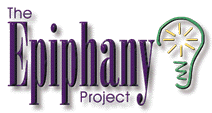 |
Lighting
Our Way Across The Divide: The Epiphany Project |
|---|
| Date: 12 Jan 1997 09:41:04-0000 Cc: Epiphany-L@gmu.edu From: denatale@tiac.net Reply-to: denatale@tiac.net Subject: Institute Retrospective Hey there-- I don't know about you, but when I'm around lots of computers-and-writing folks I start to think of everything as hypertext. You might say that everything has always been non-linear and linked, that I'm just getting around to noticing it, but I do think that hyper-type-talk changes the way we perceive everyday experience every bit as much as it represents previously unacknowledged experiential realities. What might this Institute look like as a Web presentation, rendered in hypertext? Seems to me that there were four major dimensions: things said, things done, people, and Epiphany itself. ** Things Said: In retrospect the Institute experience was primarily an immersion in interesting words and thoughts -- lots was said by many different voices. How to represent that? Transcripts of some of the sessions? Selected quotes from post-Institute participant reflections? At what point do events begin and end? Our Institute-related dialogue didn't stop at the end of our four days, as evidenced by Institute-related conversational threads on the Epiphany-L listserv. The way that Institute words and experiences *really* live in my memory is as random connections. These thoughts arrange and rearrange themselves in my mind, like a Random Institute Thoughts Link Generator, each combination creating a new opportunity for meaning. Simlations like these have their limitations, though. Some scripts don't work on many older browsers. Better also provide a list of these interesting thoughts so that low-end users can use it to make their own thought links. On the last day of the institute, Dickie Selfe asked each of us to write about the challenges we face in creating a culture of support for teaching with technology on our campuses -- I'd definitely want to include some of those concerns because they're been wafting around, lingering in my memory. ** Things Done: Claudine Keenan put together a really nice institute schedule before the conference, providing a useful overview of the experience (complete with links to related web-based resources). The conference schedule was designed in accordance with Epiphany's "Practical STEPS" program, a five-semester sequence of questions designed to help mainstream faculty make meaningful use of technology in their teaching ("STEPS" stands for a "Strategy for Technologically-Enlightened Pedagogies"). ** People: In a preparatory session for Institute leaders, Peter Sands posed the question, "How do you grow a community?" Many educators dedicated to computer-mediated learning note a sense of loneliness on their home campuses. Epiphany provides a context for story-swapping, humor, and comraderie that mitigates our sense of isolation. A number of the January Institute leaders were summer session "graduates". Our decentralized organizational structure, fluidity of roles, and expanding leadership network means that some of January's participants may well become leaders in the near future. Thanks to Judy Williamson, we have a photo album of Institute pictures to share with you. ** Epiphany's Homepage: Epiphany's staff, volunteers, and consultants worked long hours to get Epiphany's web site up in time for the conference. The most recent print edition of Epiphany's _Field Guide to 21st Century Writing_ arrived barely in the nick of time. Wednesday evening, participants enjoyed the dubious honor of helping leaders collate the 240-page _Field Guide_ notebooks! Noting that Epiphany's web site contains the most accurate full-text versions of _Field Guide_ articles, Greg Ritter commented that it's just one more example in support of Negroponte's argument that Internet-based communication (moving bytes) is infinitely more efficient than traditional print (moving atoms). One final reflection: In _<designing web graphics>_, Linda Weinman explains that one of the differences between paper-based artwork and Internet graphics is that computer screens use light to render color. On computer screens, the presence of all colors creates white, whereas on paper the presence of all colors creates black. This got me to thinking that, like the artist Picasso, we're all now sketching our words on a canvas of light that is as energized as it is fleeting. Fred Kemp noted during the conference that it's not just the well-chosen word that communicates, but rather a dialogic accumulation of texts that create a meaning greater than constituant utterances. With each new Epiphany venture we are adding facets to our community and layers to our work, building an increasingly rich set of resources and relationships. With each voice there is more color and increased clarity. Viewed from this perspective, Epiphany genuinely is a "feast of lights." ********************************* |